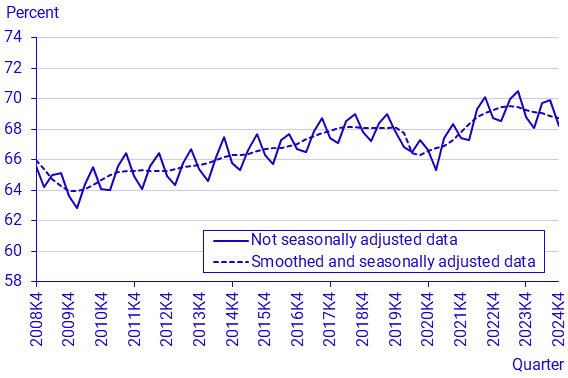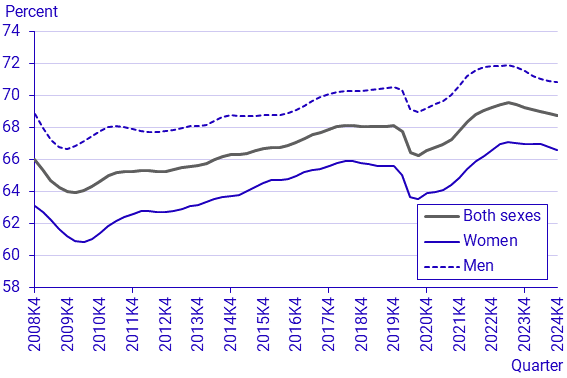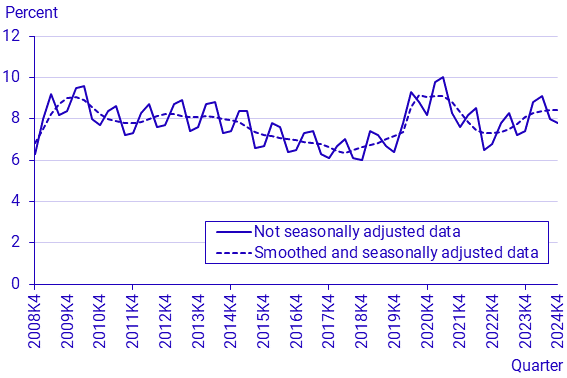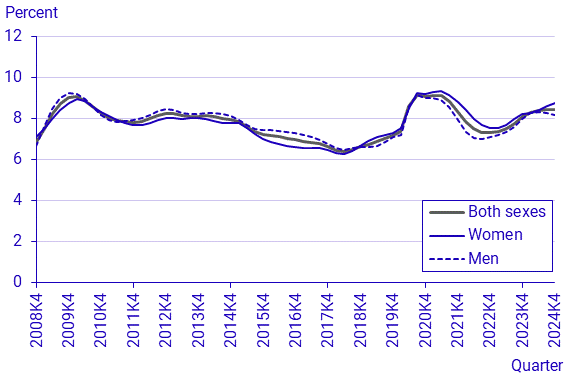Labour Force Survey (LFS), fourth quarter 2024
Employment continues to decrease
Statistical news from Statistics Sweden 2025-02-04 8.00
In the fourth quarter of 2024, the number of employed people amounted to 5 194 000, not seasonally adjusted. The employment rate amounted to 68.2 percent, a decrease of 0.6 percentage points. The average number of hours worked per week amounted to 164.0 million hours. There were 438 000 unemployed people, which corresponds to an unemployment rate of 7.8 percent. Seasonally adjusted and smoothed data shows a decrease in the share of employed people. According to seasonally adjusted and smoothed data, the unemployment rate was 8.4 percent.
– Employment continued to decrease during the fourth quarter of 2024. According to seasonally adjusted and smoothed data, we also see a decrease in the labour force participation rate but at the same time an increase in the number of hours worked, says Charlotta Olofsson, statistician at the Labour Force Surveys at Statistics Sweden.
The labour force
The number of people in the labour force aged 15-74 years amounted to 5 632 000 during the fourth quarter of 2024, not seasonally adjusted. The number of women in the labour force amounted to 2 686 000 and the number of men was 2 946 000. The relative labour force participation rate amounted to 73.9 percent. Among women, the labour force participation rate was 71.7 percent and among men it was 76.2 percent.
According to seasonally adjusted and smoothed data, the number of people in the labour force during the fourth quarter of 2024 amounted to 5 715 000, which corresponds to 75.1 percent of the population. This is a decrease in the share of people in the labour force compared to adjacent quarters.
Employment
In the fourth quarter of 2024, the number of employed persons amounted to 5 194 000 people aged 15–74 years, not seasonally adjusted. This corresponds to an employment rate of 68.2 percent, a decrease of 0.6 percentage points compared to the corresponding quarter in 2023. Among women, the number of employed was 2 468 000 and among men the number of employed amounted to 2 727 000. The employment rate for women was 65.8 percent and among men it was 70.5 percent, a decrease of 0.8 percentage points. There were 486 000 young people aged 15–24 years in employment. This corresponds to an employment rate of 40.1 percent.
For people aged 15–74 years, seasonally adjusted and smoothed data shows a decrease in the share of employed people compared to adjacent quarters. Seasonally adjusted and smoothed, the number of employed people during the fourth quarter of 2024 amounted to 5 233 000. This corresponds to an employment rate of 68.7 percent.
Employees
In the fourth quarter of 2024, there were 4 694 000 employees, not seasonally adjusted. The number of employed women was 2 322 000 and the number of employed men amounted to 2 372 000. The number of permanent employees amounted to 4 089 000. Among permanent employees, the number of women amounted to 1 992 000 and the number of men was 2 097 000. There were 605 000 temporary employees, a decrease of 39 000. Among them 330 000 were women and 275 000 were men.
According to seasonally adjusted and smoothed, the number of employees amounted to 4 732 000. Among employees, 4 101 000 had a permanent employment and 631 000 a temporary employment.
Hours worked
The average number of hours worked per week in the fourth quarter of 2024 amounted to 164.0 million hours, not seasonally adjusted. According to seasonally adjusted and smoothed data, the number of hours worked averaged to 155.5 million per week. This is an increase compared to adjacent quarters.
Most employed people have an agreed working time of 35 hours or more per week, that is, full-time work. In the fourth quarter of 2024, 4 066 000 people worked full time. Among them 1 787 000 were women and the number of men was 2 280 000. In total, 288 000 people worked short part-time (1–19 hours), and the number of people who worked long part time (20-34 hours) amounted to 599 000 people.
The average actual hours worked among employed people aged 15–74 years amounted to 31.6 hours per week in the fourth quarter of 2024. Women worked 29.4 hours per week and men 33.6 hours per week.
Underemployment
Among employed people aged 15–74 years, 346 000 were underemployed in the fourth quarter of 2024. The number of underemployed women amounted to 167 000 and the number of men was 179 000. Underemployed people accounted for 6.7 percent of employed people.
Unemployment
In the fourth quarter of 2024, there were 438 000 unemployed people aged 15–74 years, not seasonally adjusted. The unemployment rate amounted to 7.8 percent. There were 219 000 unemployed women, and the number of unemployed men was 219 000. The unemployment rate for women was 8.1 percent. The corresponding number for men was 7.4 percent.
For people aged 15–74 years, seasonally adjusted and smoothed data shows that the number of unemployed amounted to 482 000 in the fourth quarter of 2024, which corresponds to an unemployment rate of 8.4 percent.
There were 150 000 long-term unemployed people (unemployed for at least 27 weeks) aged 15–74 years in the fourth quarter of 2024, not seasonally adjusted. Among long-term unemployed people, the number of women was 74 000 and the number of men amounted to 77 000.
The number of unemployed young people aged 15–24 years amounted to 130 000, not seasonally adjusted. This corresponds to an unemployment rate of 21.1 percent. According to seasonally adjusted and smoothed data the number of unemployed young people aged 15–24 years amounted to 163 000, corresponding to an unemployment rate of 23.9 percent.
Not in the labour force
The group 'not in the labour force' includes people who are not classified as employed nor as unemployed. In the fourth quarter of 2024, there were 1 985 000 people not in the labour force. The number of women not in the labour force was 1 062 000 and the number of men was 923 000.
Among people not in the labour force, 826 000 were retired, which is a decrease of 31 000, 687 000 were full-time students, an increase of 44 000, and 314 000 people reported that they were on long-term sick leave.
Latent job seekers
There were 325 000 latent job seekers aged 15–74 years in the fourth quarter of 2024, which is an increase of 37 000 compared to the corresponding quarter previous year. Among them, 163 000 were women, an increase of 28 000, and 163 000 were men. Among young people aged 15–24 years, the number of latent job seekers was 178 000, which is an increase of 25 000.
Unused labour supply
Unemployed people, underemployed people and latent job seekers together comprise the unused labour supply. In the fourth quarter of 2024, the unused labour supply averaged 23.0 million hours per week. The unused labour supply corresponds to 575 000 full-time employments with 40-hour work weeks.
Labour market for people aged 20-65 years
The population presented by the LFS is comprised of people aged 15–74 years. However, labour market participation among younger and older in this age group is considerably lower for natural reasons, as this group contains large shares of students and retired people. To better approach what can be seen as the core of the actively working population, the situation of the age group 20–65 years is described in the following section.
The relative labour force participation rate among people aged 20–65 years amounted to 86.5 percent in the fourth quarter of 2024, not seasonally adjusted. This is a decrease of 0.8 percentage points compared to the corresponding quarter in 2023. For women, the relative workforce participation rate was 84.2 percent, and for men the number decreased by 1.2 percentage points to 88.7 percent. Seasonally adjusted and smoothed data shows a participation rate of 87.1 percent, which is a decrease compared to adjacent quarters.
In the fourth quarter of 2024, the share of employed people aged 20–65 years was 80.5 percent, not seasonally adjusted. This was a decrease of 1.1 percentage points compared to the corresponding quarter previous year. For women, the share of employed people was 78.0 percent and for men it was 82.8 percent, a decrease by 1.4 percentage points. According to seasonally adjusted and smoothed data, the employment rate amounted to 80.8 percent, which corresponds to a decrease compared to adjacent quarters.
According to not seasonally adjusted data, the unemployment rate in the age group 20–65 years amounted to 6.9 percent. The unemployment rate among women was 7.3 percent and for men it was 6.6 percent. According to seasonally adjusted and smoothed data, the unemployment rate was 7.2 percent.
Swedish born and foreign born people aged 20–65 years
The relative labour force participation rate among Swedish born people aged 20–65 years was 86.9 percent in the fourth quarter of 2024, not seasonally adjusted. Among Swedish born women the labour force participation rate was 85.2 percent, and among Swedish born men it was 88.6 percent. Among foreign born people aged 20–65 years, the relative labour force participation rate was 85.3 percent. The corresponding figure among foreign born women was 81.7 percent and 88.9 percent among foreign born men, a decrease of 3.1 percentage points. According to seasonally adjusted and smoothed data, the labour force participation rate was 87.5 percent among Swedish born people and 86.1 percent among foreign born people. That is a decrease of labour force participation rate among both Swedish born and foreign born people compared to adjacent quarters.
In the fourth quarter of 2024, the share of employed Swedish born people aged 20–65 years decreased by 1.2 percentage points and amounted to 83.2 percent, not seasonally adjusted. Among Swedish born women, the employment rate was 81.5 percent, a decrease of 1.4 percentage points, and among Swedish born men the employment rate was 84.9 percent. Among foreign born people, the employment rate was 73.1 percent. Among foreign born women, the employment rate was 68.9 percent and among foreign born men it decreased by 2.6 percentage points to 77.2 percent. Seasonally adjusted and smoothed data shows that the employment rate was 83.6 percent among Swedish born people and 73.4 percent among foreign born people. This was a decrease among Swedish born people compared to adjacent quarters.
The relative unemployment rate among Swedish born people aged 20–65 years increased by 0.6 percentage points and was 4.2 percent in the fourth quarter of 2024, not seasonally adjusted. Among Swedish born women, the unemployment rate was 4.3 percent, an increase of 0.8 percentage points, and the male unemployment rate was 4.1 percent. The unemployment rate among foreign born people was 14.3 percent. Among foreign born women it was 15.6 percent and among foreign born men the corresponding number was 13.1 percent. Seasonally adjusted and smoothed data shows that the unemployment rate was 4.5 percent among Swedish born people and 14.7 percent among foreign born people. This was an increase among Swedish born people respectively a decrease for foreign born people, compared to adjacent quarters.




Source: Statistics Sweden
Definitions and explanations
Since the LFS is a sample survey, the results are subject to some uncertainty. The LFS basic tables contain uncertainty figures and refer to non-seasonally adjusted data.
Seasonally adjusted and smoothed data (trend values): data in which normal seasonal variations have been removed, then smoothed to reduce sampling error and short-term variations. Seasonally adjusted and smoothed data may be revised following new monthly outcomes and usually does not coincide with non-seasonally adjusted data. Seasonally adjusted and smoothed data is not to be compared with non-seasonally adjusted data.
More detailed results are available in the form of figures and tables on employed persons, hours worked, unemployed persons and more, on Statistics Sweden’s website.
Next publishing will be
2025-02-17
Feel free to use the facts from this statistical news but remember to state Source: Statistics Sweden.
